Disclosure: Some links on this site are affiliate links. As Amazon Associates, we earn from qualifying purchases (at no cost to you).
Japandi style, a blend of Japanese minimalism and Scandinavian functionality, creates serene, functional, and aesthetically pleasing spaces.
The fusion of these two design philosophies results in a balanced and harmonious environment that emphasizes simplicity, natural materials, and muted color palettes.
Here are 33 Japandi bedroom design ideas to help you create a tranquil retreat in your home.
33 Japandi Bedroom Ideas
1. Neutral Color Palette
Start with a neutral color palette to set the foundation for your Japandi bedroom. Use shades of white, beige, soft gray, and muted earth tones.

These colors create a calm and serene atmosphere, perfect for relaxation. Opt for matte finishes to maintain the minimalist aesthetic and avoid overly bright or shiny surfaces.
2. Natural Materials
Incorporate natural materials such as wood, bamboo, linen, and stone. Choose furniture and decor items made from these materials to add warmth and texture to your bedroom.

Natural materials not only look beautiful but also connect the space to the natural world, promoting a sense of tranquility.
3. Low-Profile Furniture
Opt for low-profile furniture to emphasize simplicity and functionality. Japanese design often features low-to-the-ground furniture, which creates a feeling of openness and flow.

Low beds, platform beds, and simple wooden frames are ideal for achieving this look.
4. Minimalist Decor
Keep decor to a minimum to maintain a clutter-free environment. Select a few key pieces that have personal significance or aesthetic appeal.

Minimalist decor helps to keep the space peaceful and uncluttered, allowing the beauty of each item to shine.
5. Tatami Mats
Add tatami mats to your bedroom for an authentic Japanese touch. Tatami mats are traditionally used in Japanese homes and provide a soft, natural flooring option.

They can be used as an area rug or even as a mattress foundation for a low bed.
6. Muted Textiles
Choose muted textiles for bedding, curtains, and cushions. Soft, natural fabrics in understated colors enhance the serene atmosphere.

Linen, cotton, and wool are excellent choices for a Japandi bedroom, offering comfort and elegance.
7. Sliding Doors
Incorporate sliding doors or shoji screens to create flexible spaces and maintain a minimalist aesthetic. Sliding doors save space and add a traditional Japanese element to the room.

They can be used to separate areas within the bedroom or as closet doors.
8. Indoor Plants
Introduce indoor plants to bring a touch of nature into your bedroom. Plants like bonsai trees, bamboo, and ferns complement the Japandi style.

Indoor plants improve air quality and add a natural element to the space, enhancing the overall ambiance.
9. Statement Lighting
Choose statement lighting that combines form and function. Pendant lights, paper lanterns, and minimalist lamps work well in a Japandi bedroom.
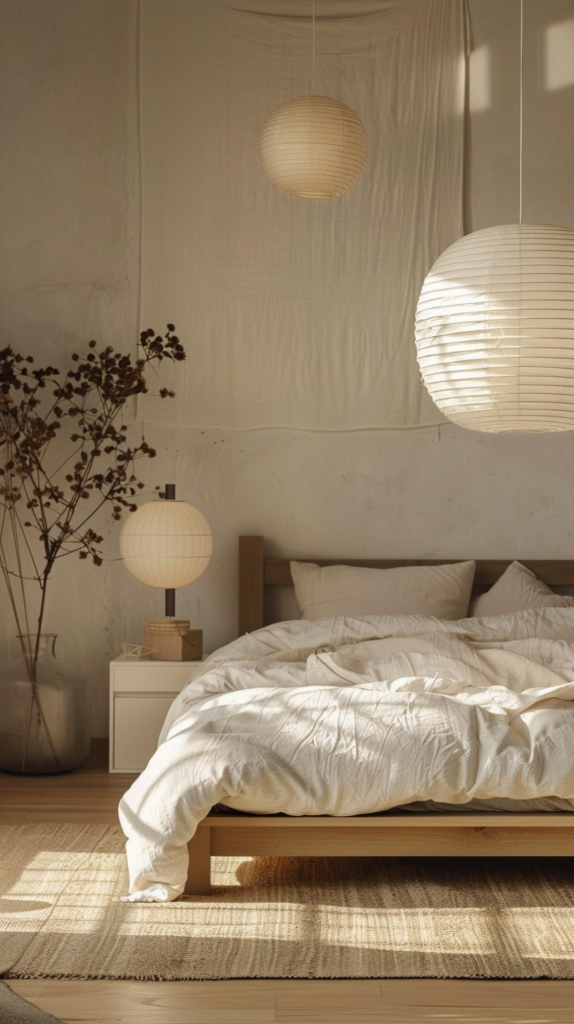
Lighting should be soft and warm, creating a cozy and inviting atmosphere.
10. Wooden Accents
Incorporate wooden accents throughout the room to add warmth and texture. Wooden headboards, nightstands, and shelves are perfect for achieving this look.

The natural grain and color variations in wood add visual interest and a touch of organic beauty.
11. Textured Walls
Add subtle texture to your walls with materials like wood paneling, grasscloth wallpaper, or textured paint. Textured walls add depth and dimension without overwhelming the minimalist aesthetic.

12. Futon Bedding
Consider using futon bedding for a traditional Japanese feel. Futons are versatile and can be folded away during the day to create more space.
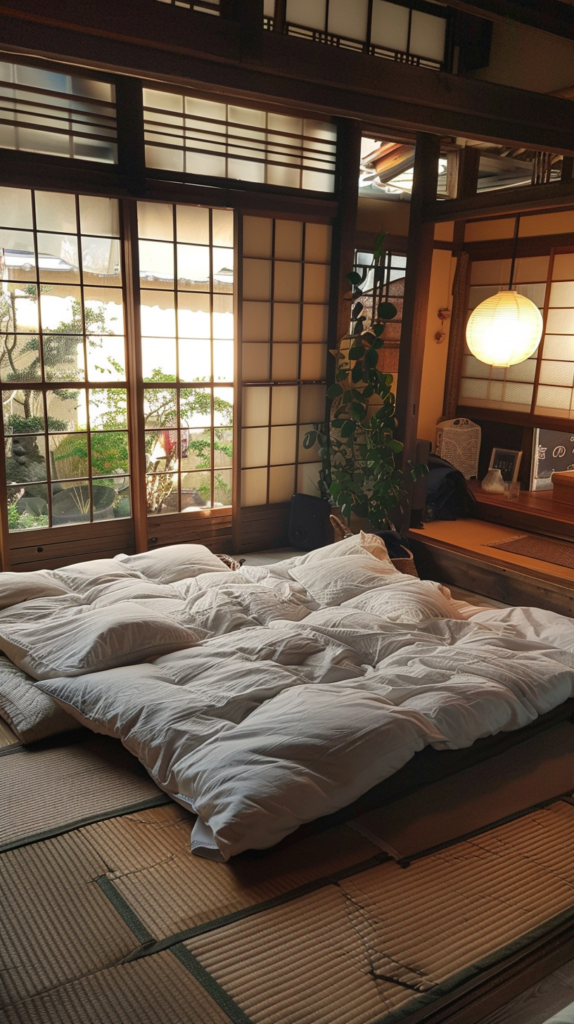
They are comfortable and can be paired with tatami mats for an authentic look.
13. Scandinavian-Inspired Furniture
Include Scandinavian-inspired furniture with clean lines and functional design. Pieces should be simple yet elegant, focusing on usability.
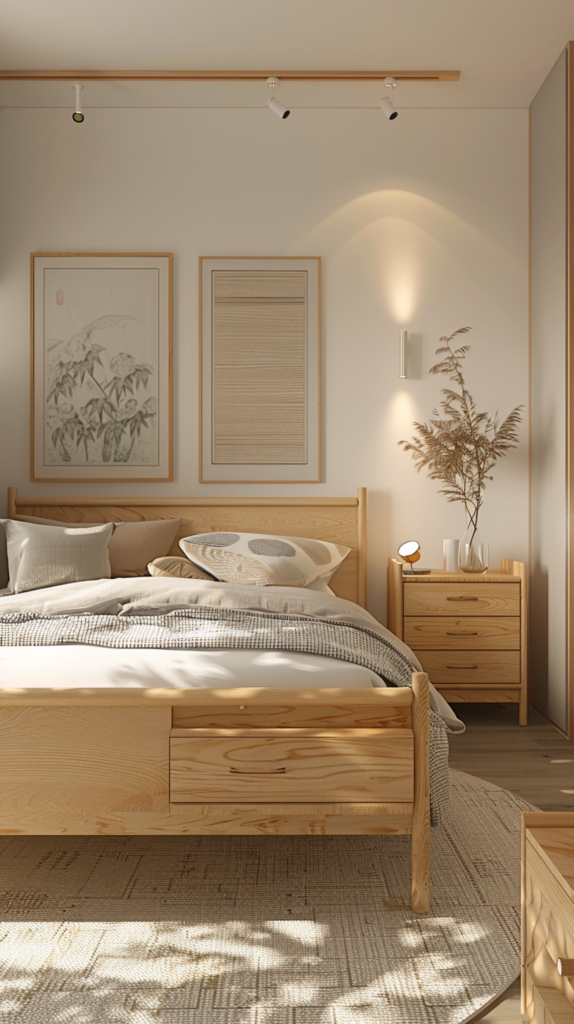
Look for items made from light-colored woods and natural materials to maintain the Japandi aesthetic.
14. Layered Textiles
Layer textiles to add warmth and comfort to your bedroom. Use throws, blankets, and cushions in coordinating colors and textures.

Layering adds depth and a cozy feel while maintaining a minimalist look.
15. Ceramic Decor
Decorate with ceramic items like vases, bowls, and decorative objects. Handcrafted ceramics add a touch of artistry and uniqueness to the space.

Choose pieces in neutral colors or with subtle, natural patterns.
16. Natural Light
Maximize natural light by using sheer curtains or blinds. Natural light enhances the sense of space and highlights the natural materials in the room.

Position mirrors to reflect light and make the room feel larger and brighter.
17. Built-In Storage
Utilize built-in storage solutions to keep the space organized and clutter-free. Built-in wardrobes, shelves, and drawers provide ample storage while maintaining a clean look.

Hidden storage helps maintain the minimalist aesthetic.
18. Calming Artwork
Select calming artwork that complements the Japandi style. Abstract paintings, nature-inspired prints, or simple line drawings work well.

Art should enhance the tranquil atmosphere without overwhelming the space.
19. Eco-Friendly Materials
Opt for eco-friendly materials to create a sustainable bedroom. Bamboo, reclaimed wood, and organic textiles are excellent choices.
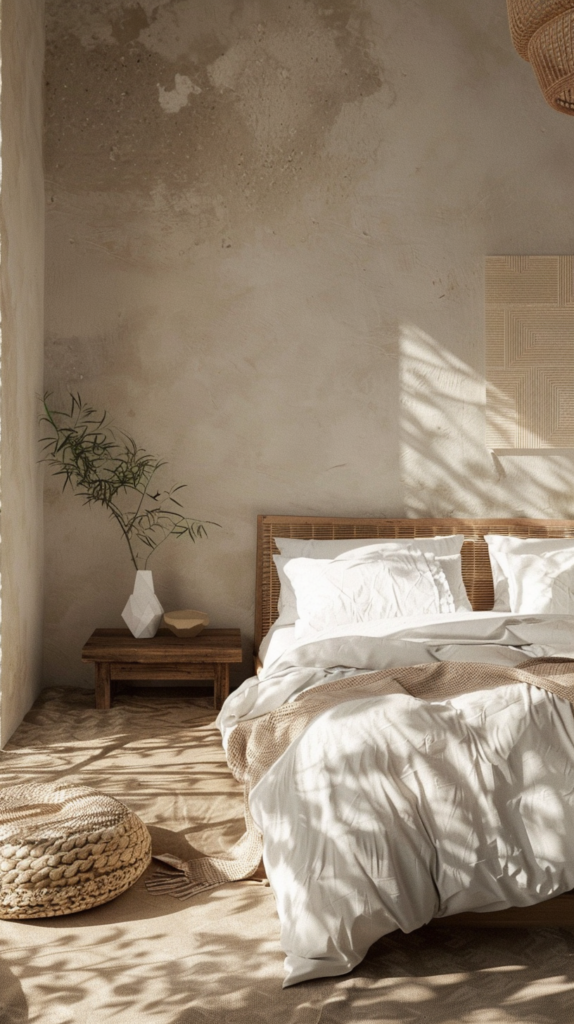
Sustainable materials contribute to a healthy environment and align with the principles of Japandi design.
20. Wabi-Sabi Elements
Incorporate Wabi-Sabi elements, which embrace imperfection and the beauty of natural aging. Choose items that have a rustic, handmade quality.

Wabi-Sabi adds a sense of authenticity and depth to the room.
21. Functional Layout
Design a functional layout that emphasizes flow and ease of movement. Ensure that furniture placement allows for easy navigation and accessibility.

A well-thought-out layout enhances the functionality and harmony of the space.
22. Low Seating
Incorporate low seating options like floor cushions, low stools, and bean bags. Low seating encourages relaxation and creates an informal, cozy atmosphere.

It also aligns with the Japanese tradition of sitting close to the ground.
23. Natural Scents
Introduce natural scents with essential oil diffusers, scented candles, or fresh flowers. Scents like lavender, eucalyptus, and cedarwood create a calming environment.

Natural scents enhance the sensory experience and contribute to a restful atmosphere.
24. Simplicity in Design
Emphasize simplicity in design by avoiding unnecessary decoration. Choose pieces that serve a purpose and contribute to the overall aesthetic. Simplicity is key to maintaining a serene and uncluttered space.

25. Organic Shapes
Incorporate organic shapes in furniture and decor. Choose items with smooth, rounded edges and natural forms. Organic shapes add softness and a natural flow to the room.

26. Tatami Platform Bed
Opt for a tatami platform bed to combine Japanese and Scandinavian elements. These beds feature a low, minimalist design with natural materials. A tatami platform bed is both stylish and functional, enhancing the Japandi aesthetic.

27. Soft Area Rugs
Add soft area rugs to create cozy spots in the room. Choose rugs with natural fibers like wool or jute in neutral colors. Rugs add warmth and texture, making the space feel more inviting.

28. Balanced Proportions
Maintain balanced proportions in furniture and decor placement. Ensure that items are evenly spaced and visually balanced. Balanced proportions contribute to a harmonious and aesthetically pleasing environment.
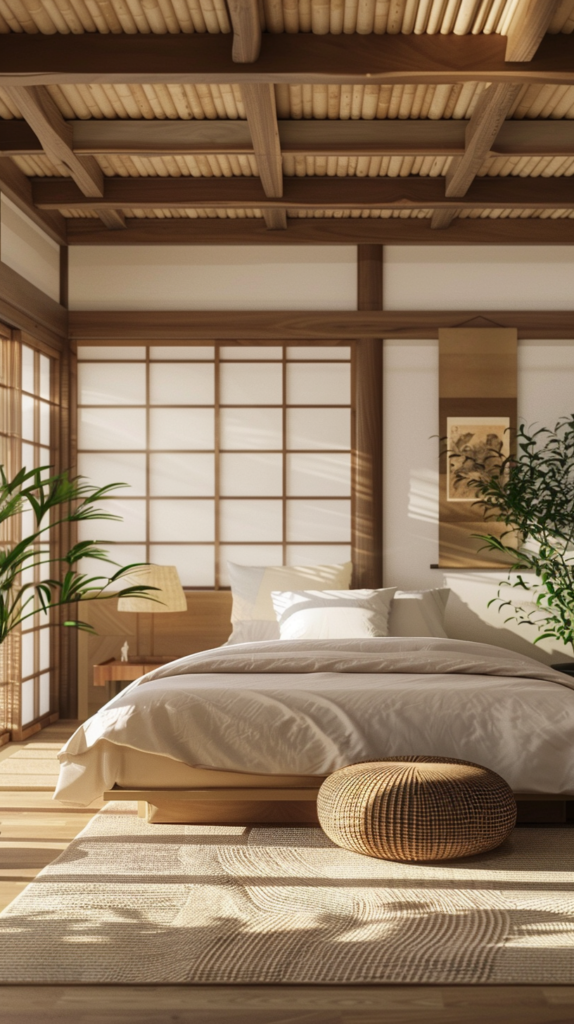
29. Simple Window Treatments
Use simple window treatments like sheer curtains or wooden blinds. Avoid heavy drapes or overly decorative treatments. Simple window treatments allow natural light to filter through and maintain a clean look.
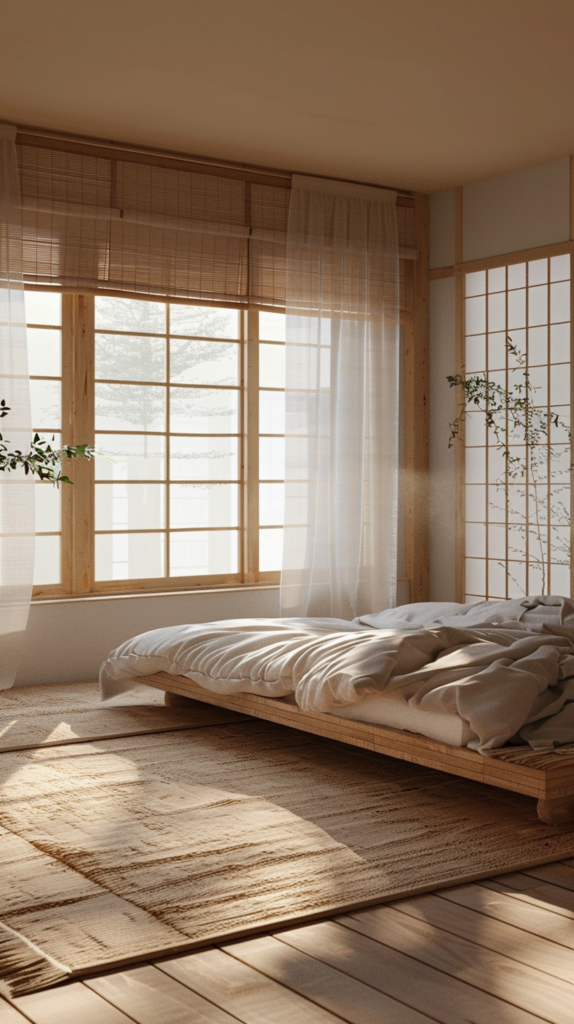
30. Accent Pieces
Incorporate accent pieces that add a pop of interest without overwhelming the space. A single statement vase, a unique piece of art, or a distinctive lamp can add character.

Accent pieces should complement the overall design and add a touch of personality.
31. Sustainable Practices
Adopt sustainable practices by choosing eco-friendly and ethically made products. Look for furniture and decor items from sustainable sources.

Sustainable practices align with the principles of Japandi design and contribute to a healthier environment.
32. Calm and Cozy Atmosphere
Create a calm and cozy atmosphere with soft lighting, comfortable textiles, and a harmonious color palette.

Focus on creating a space that feels restful and inviting. A calm and cozy atmosphere enhances relaxation and well-being.
33. Personal Touches
Add personal touches to make the space uniquely yours. Incorporate items that have personal significance or reflect your interests.

Personal touches add warmth and personality, making the bedroom feel like a true retreat.
Conclusion
Creating a Japandi bedroom involves combining the best of Japanese and Scandinavian design principles to create a space that is both functional and serene.
By incorporating these 33 ideas, you can transform your bedroom into a tranquil retreat that promotes relaxation, simplicity, and natural beauty.
Whether you’re starting from scratch or looking to refresh your current decor, these tips will help you achieve the perfect Japandi aesthetic.


